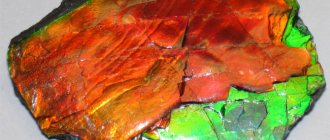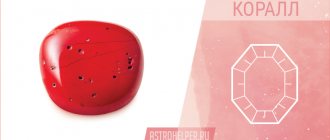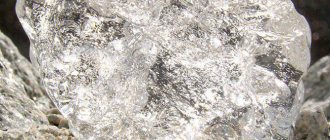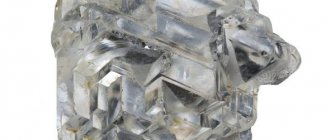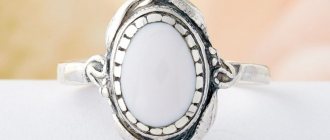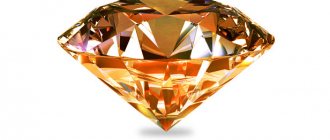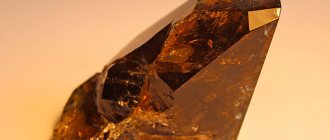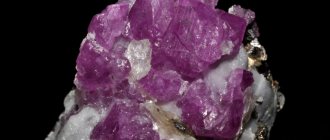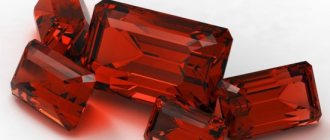Article updated 05/19/2020
Diamond is pure carbon with a small amount of impurities. A prerequisite for formation is high pressure and temperature. From the deep bowels of the earth, this stone is brought to the surface at the cost of incredible efforts in order to subsequently shine with unbridled light.
Diamond has the highest hardness level, reaching 10 on the Mohs scale. However, this mineral is fragile. With a strong impact and squeezing, it can crumble into small pieces. A stone with perfect cleavage is distinguished by a conchoidal fracture, diamond luster and absolute transparency.
Diamond is characterized by luminescence and dispersion. This manifests itself in the presence of a huge spectrum of rays of different shades when the sun's rays pass through the crystal.
History and origin
Diamond is an ancient mineral from the point of view of the first finds and mentions, and from the point of view of science, it is prehistoric. This means that people learned about diamonds as soon as they learned to find and mine various minerals. And some modern studies suggest that the age of diamond ranges from 1 to 2.5 billion years.
The discoverers of diamond, like some other precious minerals, are considered to be Indians. The treasuries of the emperors and princes of India were full of diamonds back in the days when the Persians and Greeks had just learned to smelt ore to obtain iron. However, the progress of the Indians ended there, because they did not know how to process solid minerals. The diamond has become a symbol of strength, resilience, and indestructibility of rulers. But the unprepossessing appearance of the natural stone prevented the nugget from being assessed as a jewel.
Do you know that outside India people learned about diamonds thanks to the great commander Alexander the Great. After the great campaign against India, the governor revealed several diamond stones to the Hellenic world. Then the Middle East learned about the mineral. But many more centuries passed before the stone became a true treasure for the whole world.
The turning point in the history of the stone was the 14th century, when the diamond turned into a brilliant, thanks to Flanders, where they learned to process this indestructible mineral. A little later, again in Flanders, they invented and mastered the legendary 57-facet diamond cut. This method of gem processing is still used not only for diamonds - many precious minerals are subjected to this cutting technique.
The name of the stone changed over time in the languages of many peoples, but no matter what name it bore, it always meant hardness, eternity, and indestructibility. The Greeks called the diamond “adamas”, the Romans called it “diamant”, and the Turkic people used the name “al mas”. Writers also use the words “diamond” and “adamant”, replacing with them not only the name of the stone itself, but as an independent designation, a symbol of hardness and durability of something.
The diamond once helped the Count of Saint-Germain to establish himself in the eyes of King Louis XIV. The famous magician revived Louis’s favorite stone in one day, having dealt with a defect that had bothered the ruler - an air bubble that flaunted under the surface of the crystal. Then the king finally believed in the power of the sorcerer.
As for the geological history of the stone, scientists have not come to a consensus and disputes between them still occur. There are two theories - terrestrial and cosmic. Both versions have the right to exist, as they are based on proven facts.
The Earth theory says that diamonds are formed under high pressure, between the earth's crust and the planet's core, in the mantle itself. Representatives of the space version are inclined to think that diamonds came to earth along with asteroids, which means that in space outside the planet there are all the conditions for their origin. Moreover, some crystals are considered “more mature” than the Sun.
Diamond colors and varieties
Natural stones can be divided into two large groups:
- white diamonds (colorless);
- colored
The former are valued for their transparency; the more crystalline the mineral looks, the more expensive it is. The second category includes a whole range of different shades, which depends on the admixtures of substances.
What kind of diamond is there: color of the stone and description of the composition:
- Brown stone. This is the cheapest type of diamond. The brown tint is due to the presence of iron in the composition.
- Yellow diamond. Like the previous specimen, this mineral is in the low price category. The yellowness is imparted by lithium in the crystal lattice of the nugget.
- Pink. Stone of the highest price category. Manganese gives it a delicate shade.
- Blue diamond. A very rare specimen with a high price. Its color is due to the presence of boron.
- With a purple tint. A very rare expensive diamond that acquired its spectacular hue due to the presence of hydrogen.
- Green diamond. A stone of this color is very rare. There are almost no such minerals in nature, and the available single specimens are in museums or in the collections of the richest people.
- Red. A mysterious stone around which there are various ancient legends. The nature of the appearance of the luxurious, rich shade has not been determined to this day, which is why red diamond is a very valuable and expensive mineral.
- Black Diamond. Stones of this type contain graphite, which explains their color. For a long time, these specimens were not considered precious at all. In modern times, black diamond jewelry is made and is in great demand.
Diamonds that have undergone jewelry processing are called brilliants.
After skillful polishing by a jeweler, they acquire an incredible shine and luxurious appearance, incomparable to other stones. Natural minerals are used not only for making jewelry. Diamond stone chips are an excellent tool for sharpening tools, which were known to our distant ancestors.
The durability and strength of diamond as a sharpening stone makes it popular in modern times. Diamond instruments are also used in the medical field - surgical scalpels, scissors and spare parts for dental equipment.
Mining locations
Since the discovery of the stone, diamonds have been mined by hand, from placers of various rocks in river sediments. This was the case until the 19th century, when scientists discovered diamond-bearing rocks in kimberlite pipes - underground passages filled with igneous rocks due to the explosion of volcanoes. For the first time such pipes were discovered in one of the villages of South Africa. Later, deposits were discovered on all continents of the planet, with the exception of the South Pole.
Today the diamond mining areas are:
- Russia.
- Brazil.
- Kazakhstan.
- Botswana.
- Namibia.
- SOUTH AFRICA.
- USA.
- Australia.
- Canada.
Diamonds are also found in India, but today the deposits of the mineral there are almost exhausted. The global market for the extraction, processing and supply of gems is controlled by three monopolistic companies in Brazil, Russia and Africa. They also set the market value of the stone.
Where is it used?
The scope of use of diamonds in jewelry is wide: these precious stones, after appropriate processing, are used for any jewelry. A rough diamond, even a black or “bloody” one, is practically unsuitable for setting. The frame is used exclusively in yellow and white gold or platinum.
There are many types of stone cuts. The classic one has 57 facets and provides the most vivid “game” of the stone. Not always applicable: many small crystals cannot be cut this way. They use a simplified rose cut, in the form of an ellipse or pear. The type of cut is selected depending on the size and shape of the raw crystal.
Jewelry with diamond
There is a differentiation of professional cutters in the world: in the East - in India, Thailand and China they work with small stones, up to 0.3 carats; Russia and Belgium produce medium and large diamonds; in the USA only large ones are produced.
Physical properties
Chemically, diamond is pure carbon. The special internal structure of the cube-shaped lattice provides the mineral with the highest hardness rating - 10 on the Mohs scale.
| Property | Description |
| Formula | WITH |
| Impurity | N |
| Hardness | 10 |
| Molecular mass | 12,01 |
| Density | 3.47—3.55 g/cm³ |
| Refractive index | 2,417—2,419 |
| Fragility | Lasting. |
| Cleavage | Perfect on {111}. |
| Kink | Conchoidal to the point of splintering. |
| singonia | Cubic. |
| Optical axis dispersion | Strong. |
| Twinning | Twin germination according to the spinel law is common. |
| Shine | Diamond. |
| Transparency | Transparent. |
| Color | Colorless, yellow, brown, blue, light blue, green, red, pink, black. |
Features of the stone are dispersion and luminescence. This means that the sun's rays, passing through a diamond, break up into a wide range of multi-colored rays. The surface of the diamond plays with rainbow colors, even when the stone has not yet been cut, which helps to detect the stone among the rock.
Composition and properties of the stone
Diamond stone is of carbon origin. Its most common type is a transparent diamond, which can be either colorless or have certain shades of one color or another, giving it a special attractiveness. The shine of a diamond in the sun is very bright - probably, it was this that once attracted a person to itself, prompting him to start using different types of diamonds as jewelry, and subsequently to create unique diamond specimens that received a magnificent man-made cut.
The atoms of the crystal lattice of the stone are cubic in shape. This is the reason for the high hardness ratings: the Mohs scale gives it the highest rating of ten points. But there is one subtlety that at one time craftsmen could not take into account: this is the so-called perfect cleavage, due to which diamond crystals, despite their strength, are very fragile . It was this paradoxical property that often caused valuable types of diamond to be destroyed.
As already mentioned, diamonds, the natural properties of which have not been enhanced by the hand of a good master jeweler, look very modest and sometimes even inconspicuous. What does a diamond just found in a particular deposit look like? Usually, it is a small petrified conglomerate, the surface of which looks matte, and if you pick it up, you can immediately feel a pleasant roughness.
Diamond crystals are more often found as single (or isolated), but there are also fused specimens, which are fine-crystalline formations, or varieties of larger diamonds.
Color varieties
The lion's share of mined diamonds are transparent stones, with blue luminescence and a slight tint. When determining a mineral into one category or another (jewelry or industrial needs), experts use only these criteria.
That is, a diamond that luminesces blue becomes a diamond. Let's say a subtle shade of brown - color. There are few such specimens, since most of the mined adamants are endowed with yellowness. Such stones benefit the industry. Only 2% of diamonds can become diamonds.
In addition to traditional white diamonds, there are also exotic, rare varieties:
- red;
- pink;
- blue;
- green;
- black;
- bright blue.
Such stones are considered the most expensive and unique, especially black and red diamonds. The cost of such samples is individual and ranges from several thousand dollars per carat. Interestingly, from a scientific point of view, multi-colored diamonds are an inexplicable fact.
No one knows exactly how they appear, since in the chemical composition of these stones there is not a single impurity that could be responsible for this or that shade. The only possible version is natural radioactive radiation, the degree of which affects the shade of diamonds.
Artificial diamond
Since diamond has very valuable properties for science and industry (in particular, a new generation of semiconductors is created on its basis), during the 20th century, scientists from different countries developed methods for creating artificial diamonds for industrial needs. Great success in this was achieved in the Soviet Union, where the technology for synthesizing diamond from graphite or a hydrogen-carbon mixture under high pressure and at high temperature was created and introduced into mass production.
It is used to create abrasive materials; these stones have no jewelry value. However, from a chemical point of view, “synthetic” diamonds are not synthetic at all; it is still the same pure carbon.
Interestingly, under certain conditions not found in nature (vacuum plus high temperature), diamond turns back into graphite. Even more interesting is that this stone does not melt, but burns.
Medicinal properties
Diamond has a versatile healing effect on many functions and organs of our body. The powerful positive energy of the stone is aimed at eliminating the following problems:
- inflammatory processes of any kind;
- diseases of internal organs - kidneys, bladder, lungs, stomach, liver;
- skin diseases;
- disruptions in the functioning of the cardiovascular system;
- instability of blood pressure indicators;
- nervous disorders, up to the cure of schizophrenia;
- gynecological diseases.
Diamonds have a calming effect on a person, relieving insomnia, relaxing the nervous system, relieving tension and fatigue. Thanks to a diamond, a person remains reasonable and collected even in difficult situations, maintaining a sober mind and clarity of thought.
Do you know that diamond water helps a person recover after surgery. All you have to do is keep the gem in a vessel with water for a day, and then drink it during the day.
Blue or green diamonds are known as protectors of women, especially pregnant women. Healers are confident that such a mineral can cope with all the difficulties of a delicate situation.
Variety of shapes and sizes
Diamond is a stone with very diverse morphological characteristics. The shape of diamond can be either mono- or polycrystalline, which directly determines the strength indicator. The already mentioned black carbonado has a polycrystalline structure, which was copied by scientists in the laboratory to synthetically produce a super-strong stone. Kimberlite deposits are represented exclusively by those diamonds whose shape is an octahedron or flat-edge.
There are also complex crystals with the original shape of rhombuses or cubes, among which there are specimens that have typical shapes with rounded edges - rhombodecaedroids. They occur when diamonds dissolve under the influence of kimberlite melt. As for the cuboid type of crystals, their formation is ensured by the fibrous growth of diamonds, which occurs according to the normal mechanism. By the way, laboratory-grown diamonds are most often characterized by cuboid crystals, which is one of their differences from natural stones.
The crystals of different diamonds vary: from those that can only be seen under a microscope to very large ones. For example, in 1905, a specimen weighing 0.621 kg, which is 3106 carats, was discovered in South Africa . It was studied for several months and then split into several parts. Rare stones are those whose weight exceeds 15 carats, and the rarest are those whose weight is 100 carats or more. As a rule, they certainly occupy a special place in history, and they are even given names. How to find out how many carats are in a diamond →
Magic powers
An interesting magical feature of diamond is selectivity. That is, not everyone who purchases it will love the stone. Moreover, the diamond will behave differently from other minerals, refusing to serve or sending uncomfortable vibrations in the name of getting rid of the unwanted owner. Diamond will simply do everything to show his new owner that he is not as good as he thought. Such a person is subject to all the misfortunes and troubles until he realizes that he is walking along a crooked path in life. A diamond amulet will greatly enhance good character traits.
Those whom adamant deems a worthy, noble owner will be supported by the stone in all areas of life. The mineral will protect from evil, and it can even turn this evil against the instigator. Diamond makes people more confident, brave, and resilient. Anyone who has not been brave in life will feel positive changes.
This is interesting! Since ancient times, people have noticed that diamond is a strong love talisman. The Egyptians believed that if you touch the object of your adoration with hands rubbed with diamond dust, then eternal love will accompany these two people.
So, even today single people are recommended to wear a diamond ring in order to find their soulmate. In this case, the jewelry must be worn on the left hand, and the design of the ring must be such that the stone has contact with human skin. It is believed that a gifted diamond is energetically much more powerful than the purchased one.
Another important protective feature of adamant is the neutralization of poisons. If you put the crystal in a poisoned drink and keep it there for a while, the poison will be neutralized.
Is there anything harder in nature?
The hardness of diamond stone has long been known, and it is believed that it has no equal in this regard. However, curious humanity has long been asking the question: maybe there is some kind of rock or other minerals in nature that could compete with a diamond in terms of its legendary “indestructibility”?
I would like to immediately assure everyone who is interested: diamond is the hardest mineral, and there really is no equal to it in this area. It fully lives up to its name, and only it itself can become harder if it is processed using a special method.
What determines the hardness for which diamond stones are so famous? This indicator directly depends on the composition of their crystal lattice. If the crystal lattice is processed using a certain method, removing all possible defects from it, then it is possible to obtain a new laboratory substance called “hyperdiamond” synthetically. This is a diamond whose crystal is so perfect that its strength is eleven times that of natural material. The basis was the type of durable “lattice” that was given to scientists by a rare variety of diamond called “carbonado”: a black stone. About the black diamond →
As you know, ordinary single-crystal (or single-crystal) diamonds are imperfect and have many natural flaws and cracks. It happens that they cannot withstand very high temperatures and pressure. But after specialists were able to reproduce the polycrystalline structure of carbonado in laboratory conditions, we can say with confidence that there is definitely no stone harder than such a material. It can be used to create products of a wide variety of sizes and shapes, which are extremely resistant to any temperature conditions.
Compatibility with other stones
Diamond is an independent mineral that few people respect as neighbors. Even stones of the same fiery element cannot claim friendship with diamond if they are semi-precious and, especially, ornamental minerals.
The royally capricious gem gets along only with Spinel, who bears the title of “noble,” and Ruby. Emerald or Sapphire will not keep Diamond company because they belong to the water element, although they are not inferior in value to the royal gem. Adamant is favorable to Pyrop. There can be no question of proximity to the stones of the Earth, since the vast majority of earthly minerals are cheap and carry a different energy.
How to spot a fake
It is quite difficult to distinguish a natural diamond from the proposed synthetic cubic zirconia, a transparent variety of a cheaper stone, or from glass. In fact, a specialist can most accurately determine authenticity. The appraiser checks the stone for thermal conductivity. There is also a special marker that is used to determine the naturalness of diamonds. On a natural stone, the applied line will be clear and even, while a fake will be revealed by a blurred outline of the line in the form of a dotted line.
It is also possible to independently distinguish a fake from a stone of natural origin. To do this, look at the mineral through a 12x magnifying glass. At the same time, the edges of the diamond will remain clear, while the edges of the cubic zirconia will remain bifurcated.
Rules for wearing and care
Diamond is one of the stones that is worn closer to the body. It is better for the stone to be in direct contact with the skin. That is, if it is a pendant, then the product should not be on top of a dress or blouse, but under it, on the bare part of the neck.
Before you buy diamond jewelry, choose the best day and, of course, take a companion with you. Consider this process a kind of magical ritual to reveal friendly and protective energy in the mineral. After all, only a diamond given by someone will become a true amulet.
Choose a convenient Saturday or Sunday when the weather outside is sunny and bright. And feel free to go shopping with someone. Let this someone buy a piece of diamond jewelry for you and hand it to you with the words “I give you this thing.” That, in fact, is the whole ritual.
Diamond is very easy to care for, because it is the hardest of all minerals existing on Earth. Store the items in a separate box or bag, more to protect the frame than the stone. A simple soap solution is suitable for cleaning. It is impossible to scratch a diamond, but the royal stone will not tolerate negligence towards itself.
Price
The cost of one carat of a stone depends on the characteristics of a particular sample. If we talk about how much a diamond costs on average, then for a carat of average quality you will have to pay $500. After cutting, the value of a diamond increases 3 times. One carat of a symmetrical mineral processed according to type “A” costs $2,500. A stone of the highest quality with a cut can be sold for 20 thousand dollars.
Prices per gram of finished diamond are determined according to the following parameters:
- carat;
- color;
- cutting;
- purity.
The price of a cut diamond product is assessed primarily by the characteristics of the stone. The most expensive combination - diamond and platinum, has a cost equal to buying a prestigious car.
Compatibility by name
The Royal Stone is the patron saint of strong and independent people. In many ways, a person’s character is determined by the name given to him at birth. Therefore, the diamond favors people with the names:
- Ivan. The mineral will become for him a source of vitality, self-confidence, pave the way to longevity and prosperity, and help fight any pain, be it mental or physical.
- Inna. For her, adamant symbolizes strength, invincibility, perfection, and courage.
- Vsevolod. The diamond will awaken in him virtue, courage, and lead to life victories and prosperity.
- Ilya. The talisman will drive away bad annoying thoughts and external negativity.
- A lion. The diamond will bring clarity and purity into his life, driving away evil and deceit. The amulet will awaken creativity and bring happiness to Leo’s life.
Although men predominate among the diamond's wards, nevertheless, this stone is reputed to be the best friend of girls. It simply cannot be otherwise.
Astrological affiliation
In addition to being picky about the owner’s character, a diamond is characterized by individual zodiac preferences. This gem is considered a friend of such signs.
(“+++” – the stone fits perfectly, “+” – can be worn, “-” – is strictly contraindicated):
| Zodiac sign | Compatibility |
| Aries | +++ |
| Taurus | + |
| Twins | + |
| Cancer | + |
| a lion | +++ |
| Virgo | + |
| Scales | +++ |
| Scorpion | + |
| Sagittarius | +++ |
| Capricorn | + |
| Aquarius | + |
| Fish | — |
- Aries. The stone gives the owner good luck in all areas of life. The diamond will add despair and courage to Aries, while directing these qualities in the right direction.
- Scales. This sign needs a diamond to gain decisiveness and the ability to make independent decisions.
Fire signs Leo and Sagittarius are also among the favorites. Diamond is neutral towards the rest. The only thing is that diamond does not really like the signs of the water element, since its essence is Fire. However, Cancers and Scorpios should try wearing a blue or green subtype of the gem. For Pisces, diamond is contraindicated in any form.
Application
Rough diamonds of good quality and shape are always highly valued in the jewelry community. A diamond is a diamond that has been processed (or cut) by a specialist, resulting in a shape that will best reveal its brilliance and color splendor.
Small and very small stones, which are not suitable for cutting, are used to make diamond drills, which are used to process granite and other high-strength rocks. By the way, it is the famous black carbonado diamond that is most valued in the industrial sphere for the manufacture of expensive and high-quality tools. About the use of diamonds →
Note
Persistent, indestructible, alluring, luxurious. In relation to a diamond, an endless number of epithets can be cited that describe its essence. This gem is truly majestic, although for a long time it hid its greatness under the mask of plainness. Today, diamonds occupy one of the first places in the hearts of true connoisseurs of beauty and luxury.
Photo gallery of stone
Blue
White
Yellow
Pink
Violet
Blue
colorless
5 / 5 ( 3 votes)
